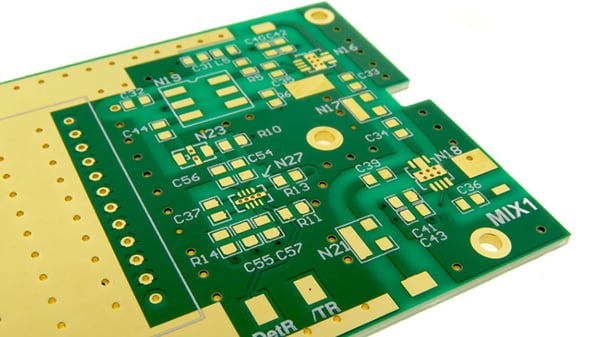Many applications today send signals between two devices to provide data or to perform a specific function. These signals may consist of radio frequencies (RF) or microwave frequencies. Typically found in the communication industry, RF/microwaves are common for satellites, radar, and navigational systems. Yet, they can also be found in smaller applications, such as garage door openers, security key card terminals, wireless alarm systems, and handheld warehouse inventory scanners.
Inside all these applications are printed circuit boards (PCBs) that allow for the signal to be transmitted and received. Traditionally, there are 4 layers to the PCB (silkscreen, solder mask, copper, and substrate). To hold all these layers together, the PCB is laminated with certain materials that are cured using heat and pressure.
Selecting the right materials for the laminate is based on numerous factors. The laminate must be strong while light without adding unnecessary weight to the application. It also must provide good thermal conductivity and thermal expansion, where the material can handle the generated heat from the electricity passing through the PCB, while allowing for an expansion of the materials from the rise in temperatures without breaking and developing cracks or interfering with the RF and microwave signals. The laminate should also have good moisture and chemical resistance, a high bond strength, and superior mechanical and electrical properties.
Over the years, the increasing high-tech demands of applications have required laminates that could keep up with the newer technology. Manufacturing trends in PCB laminates have offered companies with increased choices while also showing them a glimpse of what lies in the future with this composition material for PCBs.

Previous FR4 Laminates for PCBs
When talking about PCB laminates, FR4 was the standard commonly used for all types of circuit boards for generations. It was low-cost, reliable, and had all the positive characteristics that were desired. In addition, it was easy to use during circuit fabrication.
FR4 is a woven fiberglass reinforced fire-retardant epoxy laminate. However, as devices began to offer higher frequencies of over 500 MHz, the FR4 laminate began to experience degraded electrical performance. A higher performance FR4 was soon introduced for multilayer PCBs – FR4 glass transition temperature (FR4 Tg).
PTFE Laminates Becoming a Secondary Choice
With high-frequency technologies in PCBs gaining speed, manufacturers turned to polytetrafluoroethylene (PTFE) as a suitable laminate. Although costing more than FR4, PTFE is a synthetic thermoplastic fluoropolymer that offers excellent dielectric properties when the application uses microwaves. It also provides better dielectric loss (Df).
In the past, the two basic choices for laminates became FR4 and PTFE. While PTFE offered advantages over FR4 for high-frequency applications, a major hurdle that was experienced with this laminate was that it had a high coefficient of thermal expansion (CTE). The laminate would change properties and expand when experiencing changes in temperature.
To overcome this issue, reinforced woven glass became added to PTFE that could combat against the size changes of the laminate. Manufacturers also began experimenting with ceramic fillers and microfiber glass to increase the dielectric constant (Dk) values of PTFE and enhance the thermal coefficient of dielectric constant (TCDk), as well as to make it easier to use the laminate when fabricating PCBs. With the addition of ceramic fillers, PTFE would experience an increase of DK values from 2.1 (without fillers) to a possible 2.94 (with fillers).
Manufacturers will often use a base material of PTFE and enhance the formula to offer different material compositions. Teflon, while sounding like a separate laminate material, is another type of PTFE-based formula. When woven glass is introduced into Teflon, the laminate is easier to work with although only experienced manufacturers should handle this material because of its difficulties during the lamination process.
Other Thermoplastic Materials Offering Alternate Options
PCB lamination trends started to bring more thermoplastics into the scene for high-frequency RF and microwave circuits. In addition to PTFE, polyphenyl ether (PPE) and polyphenylene oxide (PPO) epoxy resin laminates were introduced into the PCB industry. These laminates were ideal for PCBs as the materials stood up well to long-term aging. Also, when woven glass reinforcement was placed into the thermoplastics, the mechanical properties of the laminates were also enhanced.
One tradeoff is experienced when PPE and PPO laminates dwell with the increase of Dk losses. When the RF or microwave frequency increases, there was a rapid Df increase, which is more than what is experienced with PTFE laminates. Also, PPO and PPE have a higher moisture absorption rate, which would not make them ideal for environments with high or constant moisture levels.
Additional PCB Laminate Trends
With thermoplastics such as PTFE, PPO, and PPE coming into the market, other manufacturers began looking into the positive qualities of thermoset resin technologies. Thermosets such as polyimide, BT epoxy, and Tg epoxy are commonly used for multilayer PCBs.
Polyimide
Polyimide laminates are used for flexible and rigid-flex circuit boards due to their higher levels of mechanical, chemical, and thermal properties as the resin can stand up to harsh environments. Able to handle higher RF and microwave frequencies, they can be found in military and aerospace industries.
BT Epoxy
There are some circuit boards that cannot have lead included due to its health hazards, such as in medical and food applications. Bismaleimide-Triazine (BT) epoxy resins offer high thermal resistance, electro migration, and insulation resistance.
Tg Epoxy
As we have already mentioned, glass transition temperature (Tg) epoxy laminates may be combined with other laminates to provide additional benefits when used for higher frequencies that may generate greater heat. This epoxy has vitrification temperature properties. Vitrification means that when the epoxy gains a higher temperature, it will become more rigid in nature. When there is a high Tg epoxy, it offers greater thermal performance, electrical insulation, moisture resistance, and chemical resistance with less flexibility.
CCL Laminates
Another possible laminate is copper clad laminates (CCL). CCL is used as a reinforcing material as it has wood pulp or glass fiber paper with copper cladding or foil along the outside. This laminate might also be used with FR4 for PCBs. A thin layer of CCL is placed on as the FR4 will be the last layer on the PCB. While offering physical, chemical, and mechanical performances, CCL laminates may also be used for PCBs when appearance and size are factors.
What to Know When Selecting a PCB Laminate Manufacturer
PCB laminate manufacturers will typically gain knowledge and experience to work with a specific material or set of materials. This is because not all processes and machines are interchangeable. One machine or process may not be feasible for Teflon PTFE-based formulas as it would be for creating PPE or PPO laminated PCBS. So, learning about a manufacturer's processes, equipment, and the types of materials that they are experienced with can help a company avoid getting an inferior product. It also allows for the PCB design to move forward in a productive manner without any hurdles or hang-ups that can significantly extend product lead times.
There are numerous PCB laminating companies out there for RF and microwave frequency applications. Some of the most common manufacturers are:
- Rogers Advanced Materials: Specializes in ceramic and PTFE laminates
- Arlon Electronic PCB: Recently acquired by Rogers Advanced Materials, this manufacturer offers ceramic, polyimide, and high Tg epoxy
- Taconic Advanced Dielectric Materials: Leader in PTFE laminates since 1961
- Isola High Performance PCB Laminates: Offers FR4, polyimide, and PPO laminates
All the laminating materials offer a range of advantages that may be perfect for your application, yet they also have a few drawbacks. A consumer should learn about these drawbacks to determine whether it will impact their PCB applications and to what degree. This strategy will help to narrow down the possible lamination choices to select one that will provide the best benefits for thermal expansion, thermal conductivity, dielectric properties, and other factors.
Reviewing the offerings from these manufacturers can also provide more specific information regarding the specific laminates they offer and any newer trends that will soon be coming to this industry. You should also speak with the PCB manufacturer for additional information and to help select the laminate material for the application. Some specific aspects to consider include:
- Electric, mechanical, and physical performances
- Dielectric constant
- Thermal conductivity
- Moisture, chemical, and temperature resistance
- Transition temperature
- Dielectric loss factor (Df)
- Size and appearance
- Coefficient of thermal expansion (CTE)
- Ability to operate in varying thermal environments
Summary
Due to the requirements of the RF/Microwave application, a PCBs may be designed with rigid, rigid-flex, or flexible materials to provide the best circuitry to complete the specific tasks. Here at Epec Engineered Technologies, we provide RF/Microwave PCBs for a range of industries including aerospace, medical, military, food, and outdoor applications. If you are looking for guidance with choosing the proper laminate for your application, feel free to request more information on our website.
Key Takeaways
- FR4 Has Limitations at High Frequencies: While FR4 has been the industry standard for PCB laminates due to its low cost and reliability, it loses electrical performance at frequencies above 500 MHz, making it unsuitable for many modern RF and microwave applications.
- PTFE Offers Superior Electrical Properties but Has Trade-Offs: PTFE laminates are better suited for high-frequency circuits due to their excellent dielectric properties and low loss, but they come with higher costs, more complex processing, and challenges with thermal expansion that often require reinforcement with glass or ceramic fillers.
- Emergence of Alternative Thermoplastic and Thermoset Laminates: Newer laminate materials like PPE, PPO, polyimide, BT epoxy, and high Tg epoxy offer specific RF/microwave applications performance advantages. However, each has trade-offs in terms of moisture absorption, dielectric loss, or flexibility.
- Material Selection Impacts Manufacturability and Performance: The dielectric constant (Dk), loss factor (Df), moisture resistance, and thermal conductivity of the laminate directly influence PCB performance. Proper laminate selection is crucial for achieving signal integrity, especially in high-frequency and harsh environment applications.
- Choosing the Right PCB Manufacturer is Critical: Not all PCB fabricators are equipped to handle specialized laminates like PTFE or PPO. Working with an experienced manufacturer familiar with advanced RF/microwave laminates ensures better quality, fewer production issues, and improved long-term reliability.

















